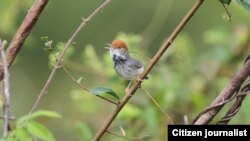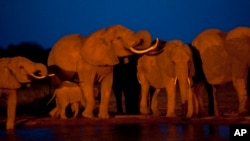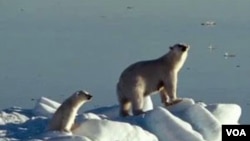From VOA Learning English, this is Science in the News.
I’m Anna Matteo.
And I’m Christopher Cruise.
Today on the program, we tell about hundreds of newly-identified plants and animals in Southeast Asia. We also report on the killing of a famous elephant in Kenya, and a new study that finds elephants can hear differences in human language. Finally, we report on efforts to protect North American polar bears.
WWF: Newly-Discovered Animals Need Protection
The World Wildlife Fund for Nature says researchers found nearly 400 new kinds of plants and animals in the Greater Mekong River area in 2012 and 2013. The WWF says researchers identified more than 2,000 other plants and animal species there during the past 17 years.
Some of the creatures were discovered in surprising places. Experts say a warbler was among the newly-identified birds found in the Greater Mekong. The warbler seemingly hid for years in and around the Cambodian capital, Phnom Penh.
Thomas Gray heads the WWF-Greater Mekong Species Program. He says the Cambodian tailorbird was the only bird added to the new species list in 2012 and 2013. He believes people study birds more than any other creature on the planet. And he says that makes it even more unusual to have found a new one.
Researchers are crediting Jodi Rowley with finding a large, bright, green flying frog. She says the discovery came as a surprise.
Ms. Rowley is with the Australian Museum Research Institute. At first, she did not recognize that she had identified a new species. She thought the flying frog was similar to a frog that was already known to scientists. But when she saw the similar creature a year later, she understood that the Vietnamese frog was something new.
“Her” frogs -- the two she saw -- were 10 centimeters long. Ms. Rowley says they have been found in only two places. Both areas are surrounded by rice crops and other agriculture.
The Greater Mekong lies in one of the world’s five most-threatened areas for plant and animal species. Thomas Gray says development is just one danger facing the creatures.
He says one of the newly-identified animals -- a giant flying squirrel from Laos -- was found at a meat market. He said that demonstrates another major threat to the species from trade in wild meat, bush meat and other wildlife products.
The WWF’s report also includes new species with unusual physical qualities or characteristics. For example, the first eyeless huntsman spider was found in Cambodia. From Vietnam, scientists identified a walking snakehead fish. It can survive for days on land.
An Ivory Thief Kills a Famous Elephant
The African Wildlife Federation recently confirmed the death of a famous elephant in Kenya. Thousands of people watched Satao over the years on visits to Tsavo East National Park. The non-profit Tsavo Trust said the huge animal was killed with a poisoned arrow.
The Trust and the Kenya Wildlife Service had been following the elephant’s movements for 18 months before his death. Wildlife workers say his very large ivory tusks made him easy to identify -- even from the air. The Wildlife Service also watched him and other elephants from the ground.
The tusks also made Satao a target. They almost touched the ground -- measuring more than two meters in length.
Wildlife groups intensified their efforts after 1,000 elephants moved to the border around the park -- a favorite area for poachers. After rains, elephants often enjoy the area’s green vegetation.
Satao was last seen alive near that border, just 300 meters from where his body was found. The area where he lived measures many kilometers from end to end, which makes guarding against attack hard. Thick greenery adds to the difficulty.
The death of Satao reminds us all of the falling numbers of African elephants. For example, Tanzania lost 80 percent of an important population of elephants. And the number of the country’s forest elephants dropped by 65 percent during the past 10 years.
Study: Elephants Can Hear Differences in Human Language
Hundreds of elephants live near humans. And it appears at least some of them have learned whether it is a man, woman or boy who is speaking, and whether the speaker is a threat.
Researchers studied elephants at Amboseli National Park in Kenya. They recorded the voices of men from the Maasai and Kamba tribes. The Maasai sometimes kill elephants because of conflict over land where they can feed their cattle. The Kamba men threaten elephants less.
Members of the different tribes recorded the same words -- “Look over there. A group of elephants is coming” -- in two languages.
Female Maasai speakers and young Maasai boys made other recordings. They were played for hundreds of elephants in 47 family groups -- with surprising results.
When the elephants heard the adult male Maasai voices, they often gathered together, or moved carefully away. Researchers called this “defensive bunching and investigative smelling.” But when the elephants heard Maasai females, boys, or adult male Kamba speaking, they did not demonstrate concern.
The researchers say this showed the elephants were able to, in their words, “correctly identify the most threatening individuals on the basis of their ethnicity, gender, and age.”
The study was published earlier this year in the Proceedings of the National Academy of Sciences.
Scientists in Alaska Are Working to Save Polar Bears
Human beings and rising temperatures have been threatening polar bears for many years. To fight that threat, scientists are working hard to save as many of the animals as possible.
A leader in that effort is the Alaska Zoo in Anchorage, Alaska. Since the 1970s, the Alaska Zoo has taken responsibility for polar bears left alone in the wild. A female bear named Ahpun was rescued as a cub by a hunter. The hunter had shot her mother after the mother attacked him. The Alaska Zoo is also home to a male polar bear named Lyutyik. He was born in Russia’s Saint Petersburg Zoo. Scientists have placed the two animals together. They hope they would produce a cub and increase the population of the threatened species.
Patrick Lampi is the executive director of the Alaska Zoo.
“For years, we’ve been the holding facility -- sometimes permanent and sometimes temporary -- for orphaned cubs coming in, whether their parents were killed or they got separated in a storm.”
He says the first three years polar bear cubs spend with their mothers are extremely important for survival. Cubs without parents can never return to the wild because they have not learned survival skills.
Susi Miller is a biologist with the United States Fish and Wildlife Service. She says the Alaska Zoo is the cubs’ first stop.
“In the last five years especially -- but actually for even longer now, 20 plus years -- they’ve been helping us deal with orphaned cubs.”
About 20,000 polar bears live in the wild around the world. Of those, about 1,500 live on Alaska’s northern coast. An unknown number are found around the Bering and Chukchi Seas.
Bears spend more time on land as warming temperatures reduce Arctic sea ice. They look for whale and fish bones outside Alaskan villages. Experts warn that the resulting increased contact with humans may lead to more conflict. And so may an increased number of people who come to see the animals. And when adult bears are killed, more cubs lose their parents.
The Alaska Zoo is working to raise $8 million for a two-part project. The goals are to increase the polar bear exhibit and build a Polar Bear Transition center. The center would receive and care for more bears.
I’m Anna Matteo.
And I’m Christopher Cruise.
Join us next week at this time for more news about science on the Voice of America.
This Science in the News was written in Special English by Jerilyn Watson from reports by VOA reporters Steve Herman in Bangkok and Joe De Capua and George Putic in Washington. It was produced by Christopher Cruise and edited by George Grow.













